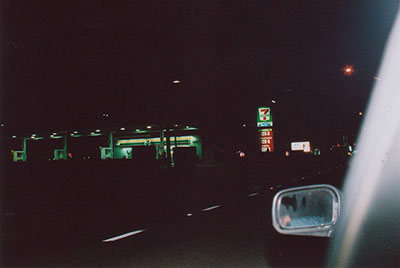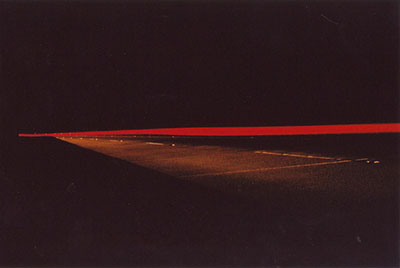the night of space – machine wilderness as conceptual soundscapes
Night shades the northeast coast of america, mid60’s. The new highway runs its trail through the flat desert, still unfinished to host traffic, rimmed by cresthills in the horizon. The car was driving on the desolated route to New Brunswick among a landscape of towers, smokestacks and winking lights.
A real scenery unfolding as an escapist machine wilderness, a term coined by cultural geographer Ronald Horvath in the same decade to describe the impact of the automobile on the western vast landscapes. The experience of this nighttime road-trip belongs nevertheless to artist Tony Smith, a poetical expression of the uncanny feelings that emerged as he drove together with three of his students on the New Jersey turnpike. Eventually, his memoir worked out as a fond introduction to minimal art:
“This drive was a revealing experience. The road and much of the landscape was artificial, and yet it couldn’t be called a work of art. It did something for me that art has never done. It seemed that there was a reality there which had not had any expression in art.”

7 Eleven, Image by Joshua D. White
Where could this unfilled reality locate its external expressions? Smith contextualized a latent -until that time- art theory, able to expand the conceptual landscape of art. The drift on meditations upon arts’ unused potentials could cite Nelson Goodman’s musings on Ways of Worldmaking (1978), who tried to commend on the processes of world-building: “Actually, I am concerned more with certain relationships among worlds than with how or whether particular worlds are made from others”. His subtle remark captures a prominent problem between the different worlds, namely how worlds interact displaying various levels of existence, from the mere tangible reality-worlds to the utmost tacit and solitary imaginative worlds. More or less, the mere volume of worlds are acts of visualization distinguished in a scale from being restricted or entirely private, up to being collective and widespread. “There is another world, but it is in this one” said once poet Paul Éluard, releasing his surrealist fictions.

Untitled, Image by Joshua D. White
The ambience of Smith’s tour had evoked to him and to his later audience unknown impressions, which reside also in a realm of existence beyond physical experience. However, Smith’s whimsical nightscape is not being perceived in a pure visual or imaginative sense. There is a distinct aural perspective in this experience, linked naturally to the physical world, yet at the same time it feels remote from it. The sonic regime is scattered over the landscape like a granulated veil, unseeable but palpable. This urban but rather rare soundscape of the vacant highway is a world able to superimpose organic quality upon other worlds, a space of invisible vibrations that vanish and arise beyond sight and inside of time and space.

Lonely Highway, Image by Joshua D. White